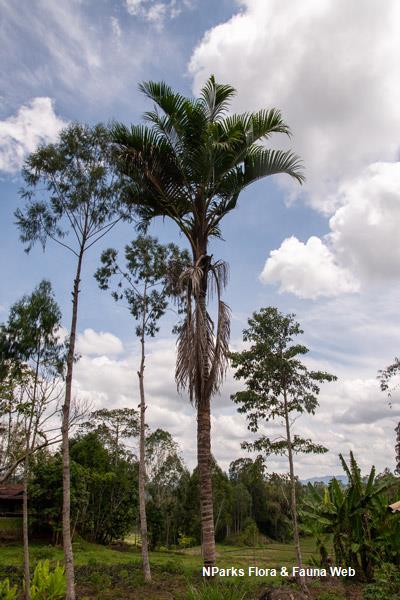Back
Pigafetta filaris (Giseke) Becc.
| Family Name: | Arecaceae (Palmae) |
| Common Name: | Pigafetta Palm, Wanga Palm |
One of the tallest palm species in Tropical Asia, Pigafetta filaris , also known as Pigafetta Palm, is a fast-growing palm that can reach up to 50 m tall in the wild. Leaf fibres are used to make threads.
Name
Classifications and Characteristics
| Plant Division | Angiosperms (Flowering Seed Plants) |
|---|---|
| Plant Growth Form | Palm |
| Lifespan (in Singapore) | Perennial |
| Mode of Nutrition | Autotrophic |
| Maximum Height | 50 m |
Biogeography
| Native Distribution | Maluka and New Guinea |
|---|---|
| Native Habitat | Terrestrial |
| Preferred Climate Zone | Tropical |
| Local Conservation Status | Non-native |
Description and Ethnobotany
| Growth Form | It is a palm that can reach up to 50 m tall and has a solitary growth habit. It is one of the tallest palm species in Tropical Asia. The stem is ringed with nodal scars and has spine-like adventitious roots near the base. |
|---|---|
| Foliage | Leaves are arching, feather-shaped (pinnate) and up to 6 m long. Leaflets are numerous, regularly arranged and slender. The leaflet margin, petiole and rachis, are armed with short spines. The leaf base (or leaf sheath) has distant spines and presence of white indumentum. |
| Flowers | Inflorescence occurs between the leaves (interfoliar) and comprises of many small flowers. |
| Fruit | Fruit is ellipsoid and covered with 13 – 15 vertical rows of scales. Each fruit contains 1 seed within. |
| Habitat | It is found in forests, up to 300 m altitude. |
| Similar | Pigafetta filaris is very similar to Pigafetta elata. The spines on the leaf base and fruits shape are key characters to tell them apart. The leaf base of P. filaris has distant spines and presence of white indumentum while P. elata has leaf base which is densely covered with dark spines. P. filaris has ellipsoid fruit covered with 13 – 15 vertical rows of scales while P. elata has round fruit covered with 11 – 12 vertical rows of scales. |
| Associated Fauna | Flowers are pollinated by insects. |
| Cultivation | It is a fast growing palm where it can reach 7 m tall in the first three years of growth. |
| Etymology | The genus Pigafetta commemorates Antonio Pigafetta (1491 – 1531), an Italian sailor who was part of the earliest voyages to sail around the world alongside Portuguese explorer, Ferdinand Magellan. Specific epithet filaris, in Latin, means thread-like. |
| Ethnobotanical Uses | Others: Leaf fibres are used by local villagers to make threads for sewing. |
Landscaping Features
| Usage Hazard - Cons | Spines/Thorns - Leaf |
|---|
Fauna, Pollination and Dispersal
| Pollination Method(s) | Biotic (Fauna) |
|---|
Plant Care and Propagation
| Light Preference | Full Sun |
|---|---|
| Water Preference | Moderate Water |
| Plant Growth Rate | Fast to Moderate |
Foliar
| Foliage Retention | Evergreen |
|---|---|
| Mature Foliage Colour(s) | Green |
| Foliar Shape(s) | Palm Fronds (Pinnate / Feather) |
| Leaf Area Index (LAI) for Green Plot Ratio | 2.5 (Palm - Solitary) |
Non - Foliar and Storage
| Trunk Type (Palm) | Aboveground, Solitary Habit |
|---|---|
| Root Type | Underground |
Fruit, Seed and Spore
| Mature Fruit Texture(s) | Scaly |
|---|---|
| Seed Quantity Per Fruit | Few (1-5) |
References
| References | Bernal, R., Martinez, B., & Sanin, M.J. (2018). The World’s Tallest Palms. Palms 62 (1): 5 – 16. Dransfield, J. (1998) Pigafetta. Principes 42 (1): 34 – 40. Dransfield, J., Uhl, N.W., Asmussen, C.B., Baker, W.J., Harley, M.M. & Lewis, C.E. (2008). Genera Palmarum. Richmond, UK: Royal Botanic Gardens, Kew. |
|---|
Others
| Master ID | 1374 |
|---|---|
| Species ID | 2667 |
| Flora Disclaimer | The information in this website has been compiled from reliable sources, such as reference works on medicinal plants. It is not a substitute for medical advice or treatment and NParks does not purport to provide any medical advice. Readers should always consult his/her physician before using or consuming a plant for medicinal purposes. |

